
Francesco Rinaldi Barolo "Cannubi" 2018
Grower: Francesco Rinaldi
Region: Piedmont, Italy
Grape Varieties: Nebbiolo
Viticulture: Organic
Category: Red
Size: 750ml
The great traditionalist estate of Francesco Rinaldi e Figli is one of the greatest names in Piemonte. Located in the town of Barolo itself, the domaine of Francesco Rinaldi was founded in 1870, when Giovanni Battista Rinaldi, the father of Francesco Rinaldi, inherited a vineyard and house in Barolo, inducing him to leave behind his work with the very large Mirafiore estate and set out on his own. His family at that time also had ties to the then greatest estate in the Barolo region, Barale-Rinaldi. Francesco's brother, Giuseppe Rinaldi, was the great grandfather of Carlotta and Marta Rinaldi (the sisters currently running the Giuseppe Rinaldi winery). The husband of Francesco's sister Margherita had the last name Barale and it was they who had the famous Barale-Rinaldi estate (where the current Francesco Rinaldi winery is found). These two superb family wineries have marched down through time side by side, both upholding the unique, traditional style of Barolo that has been championed by other great names in Piemonte, such as Bartolo Mascarello and Bruno Giacosa. One hundred and thirty years later, much of the same techniques are still used in the Francesco Rinaldi cellars to produce some of Barolo’s greatest wines. The current head of the family estate is the spry, nearly 90+ year-old Luciano Rinaldi, who took over the reigns of the family winery all the way back in 1941. Today he is ably assisted by his nieces, Paola & Piera Rinaldi, as they continue to make beautiful wines within the great traditions of Barolo, with no new oak, long macerations and long aging in large Slavonian oak botti prior to bottling. In fact, about the only thing that has changed here is that Luciano no longer crushes the grapes by foot himself, as a new press is one of the only nods to modernity in these great old cellars.
However, all of the traditions that continue to be embraced here does not mean that this is a winery lost in the past, as their beautiful wines have never been better than they are today. While the estate of Francesco Rinaldi is most famous for its long-lived and brilliant Barolo bottlings made from two of the regions greatest vineyards, Brunate and Cannubi, the entire lineup of wines up and down the quality hierarchy are made with the same painstaking care and commitment to excellence. The lower level wines are superb examples of their genres, with impressive depth, complexity and classic structures, whether they be the deep Nebbiolo d’Alba made from younger vines not destined for the Barolo or Barbaresco bottlings, the tangy and red fruity Grignolino which drinks beautifully in its youth (a rarity amongst the cellar-worthy Rinaldi lineup) or the round, full-bodied and surprisingly serious Dolcetto d’Alba “Roussot” from vineyards located within the cru of Cannubi.
Francesco Rinaldi e Figli makes two non-cru denominated bottlings, one of Barbaresco and one of Barolo, made from a blend of different parcels. The Barolo is made from vineyards in the towns of Barolo, Castiglione Faletto and La Morra. The superb Barbaresco is aged for two years in botti prior to bottling, while the standard Barolo bottling is aged for three years in large cask before it is bottled and made available for sale. Both wines are built for aging, and typically will be at their best from six to ten years out from the vintage. Like all of the wines from Piera and Paola Rinaldi, they are beautiful, classic expressions of their underlying terroirs, with well-integrated tannins, tangy acids and beautiful complexity and balance. Both improve immeasurably if decanted an hour prior to serving.
This delicate Nebbiolo opens to wild berry, rose, pressed violet, earth and powered licorice. The 2018 Barolo Cannubi takes a classic approach and underlines the elegant character of this most celebrated MGA site in the village of Barolo. The wine feels light and weightless when it first hits the palate, but don't be deceived. It offers ample power and length once you take it all in.- Wine Advocate
